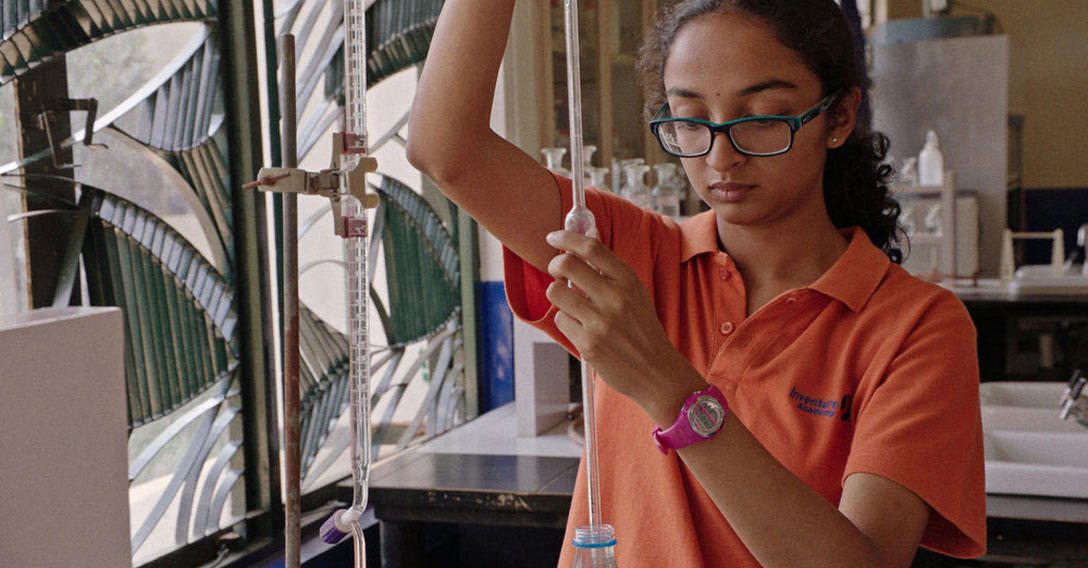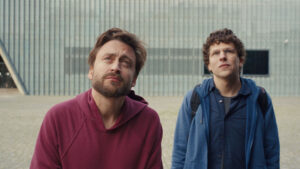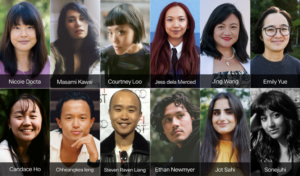Sundance Institute
It’s an artistic process that often goes unheralded, and one that certainly warrants more conversation: the day-to-day work of the nonfiction producer. To coincide with the launch of the 2019 application for the Documentary Creative Producing Lab and Fellowship, we checked in with 2017 Fellow Diane Becker and her project Inventing Tomorrow, which is directed by Laura Nix and premiered at the 2018 Sundance Film Festival. The documentary “follows six young scientists from Indonesia, Hawaii, India and Mexico as they tackle some of the most complex environmental issues facing humanity today. Each student is preparing original scientific research that he or she will defend at ISEF, the Intel International Science and Engineering Fair. Framed against the backdrop of the severe environmental threats we now face, we immerse the audience in a global view of the planetary crisis, through the eyes of the generation that will be affected by it most.”
Below, Becker shares insights on the creative roots of the project, the unexpected challenges she faced, and how we can continue to nurture producers and their work moving forward. We’ll be checking in with other Creative Producing Lab alumni and their projects in the coming months. Apply here to the 2019 Documentary Creative Producing Lab. The deadline is February 12, 2019.
Tell us about how you became involved in this film: what excited you about the material and instilled belief in your director? What was your own personal connection to needing to tell this story?
Becker: My producing partner at Fishbowl Films, Melanie Miller, heard a story on NPR in early 2015 about Taylor Wilson, a young scientist who discovered nuclear fusion in his garage at 14 years old in 2008. He was one of the 2011 winners at Intel ISEF (International Science & Engineering Fair, a program of the Society for Science & the Public). No one had really told the story of these young scientists and we thought it would make an inspirational film for people of all ages around the world. Science is a universal language.
I had worked with Motto Pictures and director Laura Nix on Laura’s last film, The Yes Men Are Revolting, and she loved the idea but did not want to make a traditional competition genre film or have it focus on who wins or loses. She wanted to tell a deeper character driven story that was motivated by a personal investment. The idea of following students who were inspired by issues where they lived, and who wanted to find ways to save the world through environmental and climate science, emerged. This made the film more urgent and emotional. This next generation does not have the luxury to ignore the problems the planet faces. They are not bound by politics or money. They see problems differently and we need to do everything we can to support them because our generation has failed.
I have an 8-year-old son. He is curious and passionate about creating things and is beginning to become more interested in science every day. I loved the idea of making a film that he would be excited and inspired by. I see young kids idolize all these “stars” on YouTube and the idea that we could disrupt some of that attention with kids who are curious about the world and using science to make change excited me.

How did you find your producing partners, and how did you know they were the right fit for you and the project?
Becker: Melanie and I have had our company, Fishbowl Films, since 2009. I have worked with Julie Goldman and Chris Clements at Motto Pictures for many years and we all had worked with Laura on her last film. Having them as our executive producers was the perfect fit. This was an ambitious project to undertake in what amounts to a miniscule amount of time in the documentary world. I knew that they would challenge our team and support us from beginning to end.
What was the most difficult part of the fundraising process? What were your key takeaways?
Becker: The most difficult part of the process was time, or lack of it. ISEF happens once a year and we scouted the fair in Phoenix, AZ, in May 2016 to make sure we knew we had a film. That became apparent from the first day on the floor of the exhibit hall meeting dozens of incredible students and listening to them talk about their science research. The fair was taking place in Los Angeles in 2017 and since we are all based in LA, we were motivated to push the development and fundraising into high gear to take advantage of filming in our hometown.
We were invited to pitch the film as a development project at the 2016 Sundance Catalyst Labs. That experience was pivotal in keeping us on schedule for 2017. Catalyst was an incredible opportunity for us to put together all the fundamentals of what it would mean to produce the film: proof of concept, a business plan, pitching to potential investors, and a rigorous exploration of the story and how we planned to tell it.
Our biggest challenge came from having to continue fundraising throughout the production of the film. Everything about this film was ambitious: from its timeline, to its global storytelling, to its post-production calendar. We needed to figure out a way to be persistent. Grant writing takes time and doing that while in the middle of production can feel near impossible. We were fortunate enough to receive grants along the way from the Sundance Documentary Fund, the Redford Center, Glassbreaker Films, and individual donors. We were raising money to pay for the film right up to its premiere at the 2018 Sundance Film Festival in January.
My biggest takeaway is that you have to keep lines of communication open with potential investors and organizations, as they tend to have different timelines and motivations of when they come on board and for how much. You have to keep the conversation going and continue knocking on doors as there are many times that people you initially think may not be able to help you will come through, often just when you need it the most.
Going into post-production on the film, what did you not anticipate would be difficult? Conversely, what worried you going into it, but then turned out to be great?
Becker: I never could have predicted some of the obstacles that we have faced over the last year as we premiered the film and sent it into the world. We were aware of another project that was about the same science fair but our team had been told that it was to be a series. So we were totally blindsided when we discovered their mandate changed and they would also premiere a feature film at Sundance to be sold. Obviously there are often films about the same subject, and while these two films take very different approaches on the same fair, there has been near constant comparison and confusion for the last year, which has been very frustrating.
The footprint of another film made it challenging for us in the current marketplace given what the climate for nonfiction sales was in January 2018 and throughout much of this past year. It’s certainly a scenario that many other films have faced, but when you are trying to sell something during even more risk averse times, it makes the task that much harder. Laura had a vision for this film that was somewhat radical: the film was independently financed and produced with a majority of women and minorities on the crew, it’s a non-competition/competition film, an American film but a completely global point of view: many of our (mostly non-white) kids speaking other languages. So much of this story is universal, which is why when audiences see it, they do respond positively—they see their families, they see their children, they see themselves.
Despite the challenges, we have remained nimble and have slowly built our audience over time. We were able to pivot quickly and create a hybrid release with multiple partners alongside the efforts of our ambitious impact/education platform. We put the film out theatrically in the U.S. this fall and have partnered with Cinephil for foreign sales. We continue to expand and grow independently while we explore more distribution opportunities for other outlets, including broadcast. I am excited for where we want to take the film in 2019. We remain resilient and I’m incredibly humbled by the efforts of everyone on our team, but special mention goes to producer Melanie Miller, whose background in independent distribution was invaluable in navigating the film around constantly challenging circumstances.
This experience has been a master class in the realities of the modern independent marketplace and I feel like we have so much knowledge to share: many filmmakers do not get big sales or distribution companies to release their films and there needs to be more transparency between producers and filmmakers as to how to make the best decisions for getting their films to audiences because you do have choices.
I was worried initially about raising money on such a tight schedule. Ultimately we found partners who not only believed in the project and its message but who supported and believed in the filmmaking team and all the efforts we took to make the film a big, cinematic, hopeful experience.

In looking back, what is the one piece of advice you’d give yourself going into making this film?
Becker: Stay true to yourself. Don’t be afraid to trust your instincts and have confidence in your ability to make the best decisions for the project, even if it sometimes means that people don’t agree with you or like you for it. Producers are usually the first people on a film and they are most definitely always the last people left to deal with every little thing that happens beyond the festival premiere and distribution of the film. Your voice is critical to the collaborative process.
What advice would you give emerging producers to develop a healthy collaboration with your director?
Becker: Trust falls! Making time to create a bond outside the film whether it’s at a bar getting drunk, hiking, going to a baseball game, or seeing movies together. I know the producer-director relationship is paramount to the success of a film both onscreen and off. Making a great film involves a deep level of trust and respect. The creative process is emotional at its core. Producers should always support the vision of the director, but that doesn’t mean saying yes or agreeing with them all the time. Part of the process is working through friction, it’s diving into the creative abyss and it’s the job of a producer to not only be able to plunge those depths but to get up out of the hole and see the project from above.
It’s also very important for young producers to establish their creative voices with directors. You aren’t just there to schedule, budget, hire crew, and buy lunch on location. You need to be able to communicate creatively, and if your director respects you, they will listen. If they trust you, they might sometimes run with the idea. Your ideas are not your ego, so it’s not about control; what’s best for the story and the film should always be your north star.
What do you feel is the most common misperception of the role of the producer in nonfiction?
Becker: I think the most common misconception is that producers of nonfiction don’t generate ideas. And while directors often are the primary drivers of the initial idea, that wasn’t the case at the outset for us. We planted a small seed, and Laura took that seed and nurtured and grew it into her own and ran around the world with it.
What type of nonfiction projects are you interested in producing next?
Becker: I love all kinds of storytelling, but I’m most interested in stories that reveal our common humanity, especially through exploring worlds we haven’t seen represented on screen. I love stories that inspire or motivate us to reflect and make change, individually or amongst the communities we live in. I’m excited about the opportunities we have to blend nonfiction with more traditionally narrative tools, especially as I work across both spectrums. I am deeply passionate about gun violence, saving planet earth, racial injustice, social equality, and daring, poetic, original biopics of all genres.
At the end of the day, I’ve always lived by this mantra: it’s the people and the project. If you are lucky enough to draw those two cards together, you’ve been dealt a winning hand.




